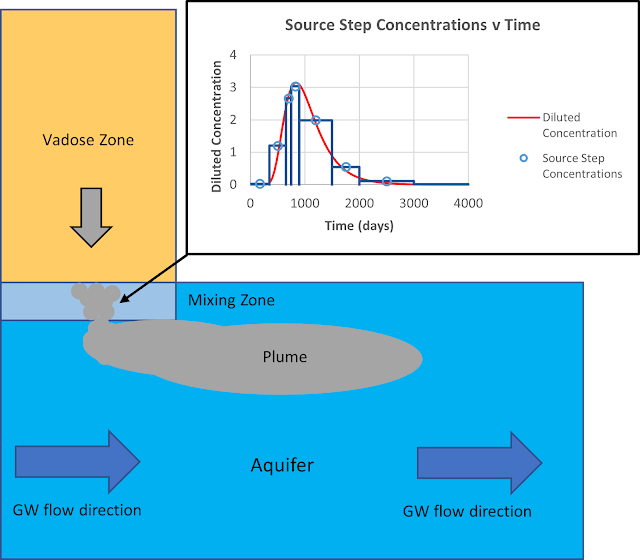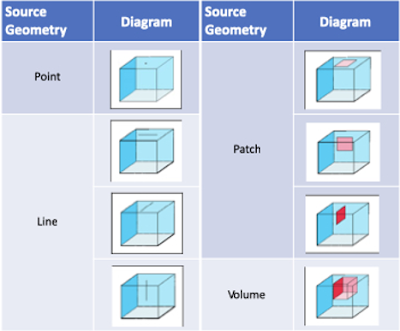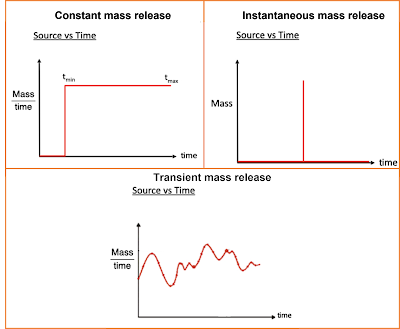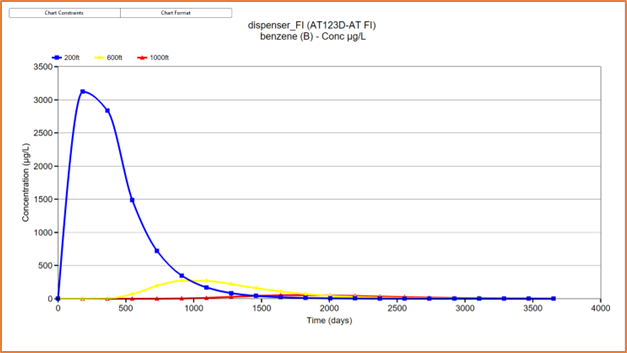TS-CHEM is pleased to announce the release of the “Soil Infiltration and Leaching Tool” (SILT), a Microsoft Excel-based spreadsheet utility that allows users to simulate one-dimensional contaminant fate and transport processes though the vadose zone in a simple, user-friendly environment. The SILT utility is a perfect companion to TS-CHEM, allowing site investigators to evaluate potential impacts to groundwater associated with contaminated soil, and estimate contaminant source terms that can then be incorporated into TS-CHEM and used to estimate the extent and duration of resulting contaminant plumes.
 |
| Figure 1: Vadose Zone Transport Conceptual Model for SILT |
SILT simulates contaminant transport from the soil source, through the vadose zone, to a groundwater contaminant source zone in three basic steps:
1. The initial source zone water concentration, located in the Source Zone (of user-specified vertical thickness), is calculated after partitioning of the user-specified Source Zone Total Soil concentration among the solid-, air- and dissolved phases
2. The dissolved phase contaminant source is transported vertically downward through the Vadose Zone, being acted upon by dispersion and degradation processes, until it reaches the groundwater table, producing a leachate breakthrough curve
3. At the bottom of the vadose zone, leachate (at the calculated flux rate and concentration) is delivered to a mixing zone at the top of the water table. When the infiltrating soil water reaches the water table, it is mixed with groundwater and the contaminant is diluted (using a Dilution Attenuation Factor (DAF)), resulting in a lower concentration. The diluted concentration data can then be used for comparison to published groundwater standards, and/or utilized to calculate source terms for groundwater plume models (such as TS-CHEM).
 |
| Figure 2: Groundwater Source Term Conceptual Model for SILT. |
SILT’s Interface is set up in an intuitive manner, with a series of worksheets that allow for a streamlined, step-by-step workflow. These worksheets are described below.
- Step 1 – Source Zone – In this worksheet, the user can specify fate and transport parameters for the contaminant of concern in the soil source zone, as well as the amount of time soil leachate concentrations will be calculated for, and the nature of the source (e.g., constant source, decaying source, or variable source concentrations), allowing the user to estimate soil source concentrations through time.
- Steps 2 and 3 – Vadose Zone and Mixing Zone – Using the soil source zone concentrations estimated in Step 1, the Vadose Zone and Mixing Zone worksheet allows the user to input properties of the vadose zone soils (e.g., distance from bottom of source to water table, water content, and seepage velocity) and the contaminant as it migrates downward through the vadose zone (e.g., decay rates in water and soil) to estimate leachate concentrations at the bottom of the soil column.
The leachate concentrations estimated as part of Step 2, along with a DAF value (which can be specified by the user or calculated using multiple methods) are then used to estimate dissolved-phase concentrations in mixing zone groundwater beneath the soil source zone.
 |
| Figure 5: Worksheet layout for the “2 Vadose & 3 MixingZone” Tab – Step 3 |
- Step 4 – Plume Model Source Steps – In this worksheet, the user can discretize the diluted mixing zone groundwater concentration data estimated in Step 3 into a specific number of source concentration steps (each with its own duration), which can then be incorporated into a groundwater contaminant plume model (such as TS-CHEM) as a source term.
 |
| Figure 6: Worksheet layout for the 4 Plume Source Steps Tab. |
SILT also incorporates a number of features that facilitate
model input, and allow for easy export of model results. For example, SILT includes a “unit
conversion” feature, which allows the user to enter a variety of commonly used
units for most input parameters, which are automatically converted by the model
before running model calculations. This feature prevents unnecessary confusion
related to units and ensures model output is consistent and accurate, while
also allowing greater flexibility.
Additionally, users can export time series charts of model output with
the click of a button (including modeled source concentrations, leachate
concentrations, diluted groundwater concentrations in the mixing zone, and
plume model source steps). Model generated time step source concentrations can
also be exported to a comma-delimited .csv file, allowing for easy
incorporation into groundwater plume models as a source term.
SILT includes a detailed User Guide which provides a comprehensive overview of the SILT utility, step-by-step instructions for all model inputs, and thorough descriptions of the calculations that are performed in SILT. And, if you’re not sure where to start, SILT comes packaged with a built-in example soil leaching model that simulates migration of TCE through the vadose zone, and is based on vadose zone fate and transport parameters presented in Sanders (1995). Simply click the “Sanders 1995 Example Model” button on the “1 Source Zone” tab, and all associated input parameters will be populated in the model worksheets.
The SILT utility can be downloaded for FREE from the TS-CHEM website (https://www.transportstudio.com/SILT/).































